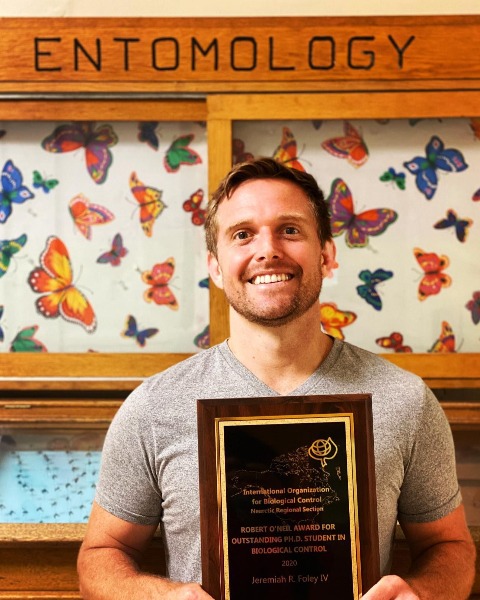P-IE
Section Symposium
Early Career Professionals Promoting Biological Control in a Changing World
11: Robert O’Neil Award for Outstanding Ph.D. Student in Biological Control: Research is to see what everybody else has seen, and to think what nobody else has thought: A graduate student's look at the Laricobius spp. system
Wednesday, November 18, 2020
1:28 PM - 1:43 PM EST

Jeremiah R. Foley, IV
Virginia Polytechnic Institute and State University
Blacksburg, Virginia
Presenting Author(s)
A handful of natural enemies, including Laricobius nigrinus Fender and L. osakensis Shiyake and Montgomery, are used as biological control agents against the invasive Adelges tsugae (Annand), a damaging pest of hemlocks (Tsuga spp.) in the eastern U.S. and Canada. A large portion (5-7 months) of the beetle’s univoltine life cycle is subterranean. Pre-pupal larvae drop from trees into the soil, where they pupate, eclose to adults, and remain in aestivation. When conditions become cooler in the fall, both Laricobius spp. and its host, A. tsugae, break their summer dormancy and begin feeding.
Over the past 15 years of mass rearing these beetles at Virginia Tech, colony mortality rates have frequently exceeded >60%. The majority of the mortality occurs during the time the insect is in the soil. Additional mortality has also been observed for those beetles that emerge from aestivation early, prior to availability of their host; leaving the beetles without a food source.
Our purpose is to present an analysis of rearing data for the past decade that identify trends in aestivation duration, timing of emergence, and survivorship as it relates to L. osakensis and L. nigrinus. It may also lead to modifying rearing methods designed to further optimize survivorship of the beetles.
Over the past 15 years of mass rearing these beetles at Virginia Tech, colony mortality rates have frequently exceeded >60%. The majority of the mortality occurs during the time the insect is in the soil. Additional mortality has also been observed for those beetles that emerge from aestivation early, prior to availability of their host; leaving the beetles without a food source.
Our purpose is to present an analysis of rearing data for the past decade that identify trends in aestivation duration, timing of emergence, and survivorship as it relates to L. osakensis and L. nigrinus. It may also lead to modifying rearing methods designed to further optimize survivorship of the beetles.

